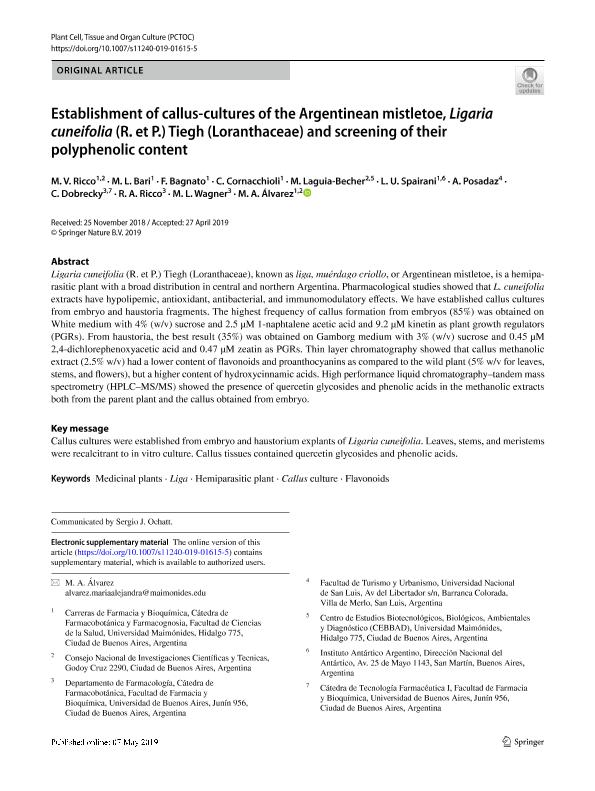Artículo
Establishment of callus-cultures of the Argentinean mistletoe, Ligaria cuneifolia (R. et P.) Tiegh (Loranthaceae) and screening of their polyphenolic content
Ricco, María Valeria ; Bari, Martín León
; Bari, Martín León ; Bagnato, Federico; Cornacchioli, Carolina; Laguía Becher, Melina
; Bagnato, Federico; Cornacchioli, Carolina; Laguía Becher, Melina ; Spairani, Leonardo Ulises; Posadaz, Ariana
; Spairani, Leonardo Ulises; Posadaz, Ariana ; Dobrecky, Cecilia Beatriz; Ricco, Rafael Alejandro; Wagner, Marcelo Luis; Alvarez, Maria Alejandra
; Dobrecky, Cecilia Beatriz; Ricco, Rafael Alejandro; Wagner, Marcelo Luis; Alvarez, Maria Alejandra
 ; Bari, Martín León
; Bari, Martín León ; Bagnato, Federico; Cornacchioli, Carolina; Laguía Becher, Melina
; Bagnato, Federico; Cornacchioli, Carolina; Laguía Becher, Melina ; Spairani, Leonardo Ulises; Posadaz, Ariana
; Spairani, Leonardo Ulises; Posadaz, Ariana ; Dobrecky, Cecilia Beatriz; Ricco, Rafael Alejandro; Wagner, Marcelo Luis; Alvarez, Maria Alejandra
; Dobrecky, Cecilia Beatriz; Ricco, Rafael Alejandro; Wagner, Marcelo Luis; Alvarez, Maria Alejandra
Fecha de publicación:
07/2019
Editorial:
Springer
Revista:
Plant Cell, Tissue and Organ Culture
ISSN:
0167-6857
Idioma:
Inglés
Tipo de recurso:
Artículo publicado
Clasificación temática:
Resumen
Ligaria cuneifolia (R. et P.) Tiegh (Loranthaceae), known as liga, muérdago criollo, or Argentinean mistletoe, is a hemiparasitic plant with a broad distribution in central and northern Argentina. Pharmacological studies showed that L. cuneifolia extracts have hypolipemic, antioxidant, antibacterial, and immunomodulatory effects. We have established callus cultures from embryo and haustoria fragments. The highest frequency of callus formation from embryos (85%) was obtained on White medium with 4% (w/v) sucrose and 2.5 µM 1-naphtalene acetic acid and 9.2 µM kinetin as plant growth regulators (PGRs). From haustoria, the best result (35%) was obtained on Gamborg medium with 3% (w/v) sucrose and 0.45 µM 2,4-dichlorephenoxyacetic acid and 0.47 µM zeatin as PGRs. Thin layer chromatography showed that callus methanolic extract (2.5% w/v) had a lower content of flavonoids and proanthocyanins as compared to the wild plant (5% w/v for leaves, stems, and flowers), but a higher content of hydroxycinnamic acids. High performance liquid chromatography–tandem mass spectrometry (HPLC–MS/MS) showed the presence of quercetin glycosides and phenolic acids in the methanolic extracts both from the parent plant and the callus obtained from embryo.
Palabras clave:
CALLUS CULTURE
,
FLAVONOIDS
,
HEMIPARASITIC PLANT
,
LIGA
,
MEDICINAL PLANTS
Archivos asociados
Licencia
Identificadores
Colecciones
Articulos(SEDE CENTRAL)
Articulos de SEDE CENTRAL
Articulos de SEDE CENTRAL
Citación
Ricco, María Valeria; Bari, Martín León; Bagnato, Federico; Cornacchioli, Carolina; Laguía Becher, Melina; et al.; Establishment of callus-cultures of the Argentinean mistletoe, Ligaria cuneifolia (R. et P.) Tiegh (Loranthaceae) and screening of their polyphenolic content; Springer; Plant Cell, Tissue and Organ Culture; 138; 1; 7-2019; 167-180
Compartir
Altmétricas



